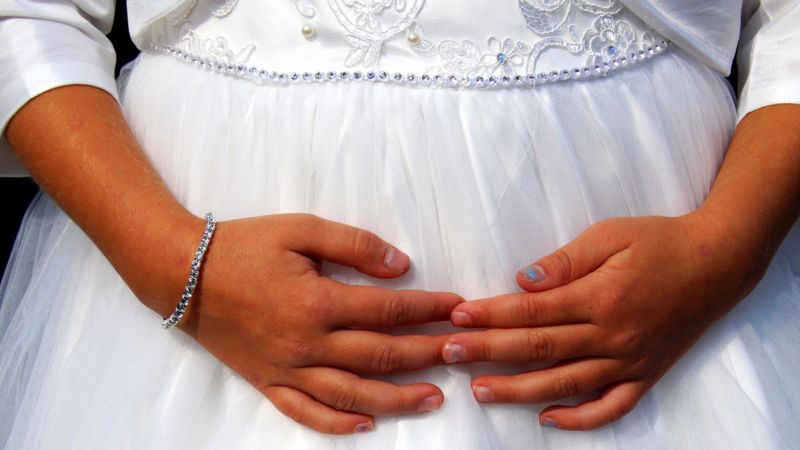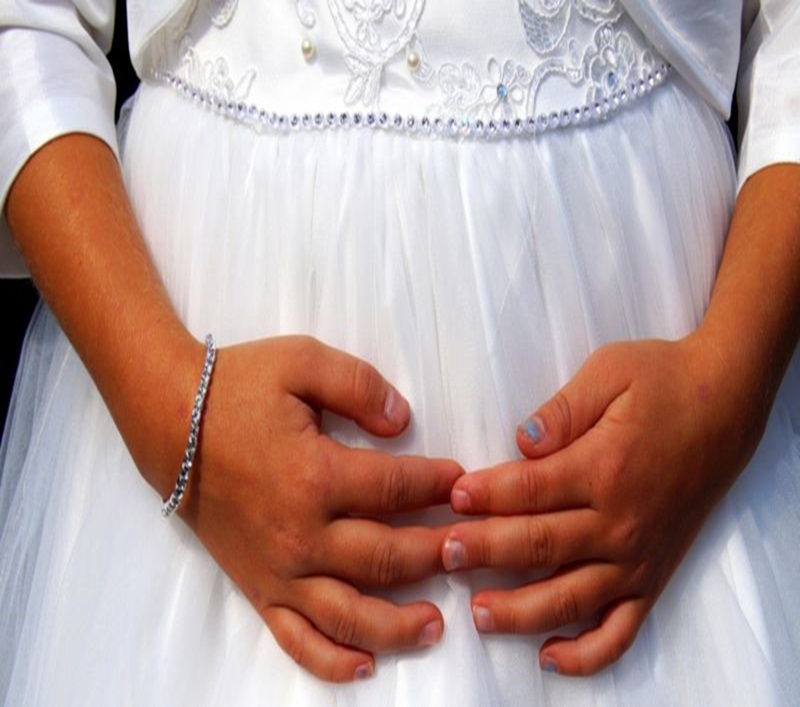
Introduction: Unveiling Untold Stories
In Iran, a troubling trend is unfolding: the harrowing tales of child brides falling victim to systematic violence. In the last two years alone (May 2021-2023), 165 femicides have occurred. Among them nameless young women and girls bear the burden of forced child marriages, enduring abuse, coercion, and unimaginable horrors. These atrocities, perpetuated by aggressive laws and patriarchal norms, demand attention and decisive action.
The murder of a 16-year-old pregnant woman by her husband, the killing of 16-year-old Shiva by her fiancé due to her reluctance to marry, and the murder of a 20-year-old woman and her two daughters by her husband paint a tragic portrait of forced marriages leading to unspeakable violence.
In some deeply disturbing instances that shook the collective conscience, the brutality faced by young women like Mona and Maryam is a stark indictment of the horrifying realities of forced marriages. Mona, just 17, was forced to marry her cousin, who was 15 years her senior, at the age of 12. Enduring relentless abuse and finding no refuge within her family or the legal system, she fled to Turkey, only to fall prey to human traffickers. Upon her return to Iran, coerced by false assurances of protection, she met a horrific end in February 2022 when her husband, in a grotesque display of so-called honor, beheaded her and paraded her severed head through streets.
Similarly, Maryam, aged 35, was forced into marriage at a shocking age of 13. Tragically, a malicious rumor about her allegedly sending a nude picture to a married man led to her demise on April 14, 2023. Her family subjected her to unimaginable torture, shaving her hair before hanging her by a rope. Even as her children clung to her legs, begging for their mother’s life, villagers callously turned a blind eye, perpetuating a culture of silence and complicity in the face of unspeakable cruelty.
The absence of official statistics has created a significant challenge in accurately gauging the extent of femicide. Many of the victims, tragically covered by the media, remain anonymous, merely described as “young women” or “young girl”, devoid of the details that define their lives and deaths.
Research conducted by Shargh newspaper reveals a chilling pattern that between May 2021 and 2023: a woman fell victim to male family member’s violence every four days. Moreover, data from the Iran Statistics Center starkly illustrates the gravity of the situation. In the first half of 2023, (March to September),at least 52 cases of femicide were officially recorded across various cities. Alarmingly, 21% of these cases involved girls under the age of 18.
Child Marriage: A Grim Reality and Legal Challenges
Every year, 12 million girls worldwide are forced into marriage before the age of 18. Despite a global decline from 23 percent to 19 percent over the last decade, child marriage is surging in some nations, notably Iran.
Shockingly, Iran’s Statistics Center revealed that in 2020 alone, 31,379 girls between the ages of 10 to 14 were married, a 10.5% increase from the previous year. This disturbing trend has persisted with 27,448 girls under 15 being married between the winter of 2021 and the fall of 2022. Disturbingly,1085 girls below 15 became mothers during this period, while 551 cases of divorce were recorded.
Child marriage is defined as any formal or informal marriage where a girl or boy is under 18 years old. It is also considered a forced marriage, as one or both parties don’t express their full and free consent to this marriage. International conventions have specific resolutions and provisions to protect children from child, early and forced marriages (CEFM).
According to the Convention on the Rights of the Child(1989) Article 1 defines a child as “every human being below the age of eighteen years.” Article 19(1) of the same convention urges governments to take appropriate measures, including legislative actions, to protect children from all forms of violence including sexual abuse.
Additionally, the Universal Declaration of Human Rights (1948) in Article 16(2) emphasizes that marriage should only occur with the free and full consent of both parties involved. The The UN Convention on the Elimination of Discrimination against Women (CEDAW, 1979) in Article 16(1) mandates countries to take all necessary measures to eliminate discrimination against women in all matters related to marriage.
Additionally, recognizing the detrimental consequences of child marriage and its violation of human rights, the Human Rights Council adopted a resolution on 11 July 2019 addressing the repercussions of child, early, and forced marriage. Subsequently, on 15 November 2022, the United Nations General Assembly, with the support of 125 co-sponsoring countries, passed a resolution aimed at ending child, early, and forced marriage (CEFM). This resolution reaffirmed six previous resolutions dating back to 2014. However, despite the escalating rates of child marriage, Iran did not join the co-sponsoring countries.
It is important to note that Iran has not ratified the Convention on Elimination of Discrimination against Women (CEDAW). Despite having approved the child rights convention nearly 30 years ago, Iran has not amended its laws comprehensively to safeguard children’s rights in all aspects. The existing civic laws in Iran remain a fundamental factor perpetuating and shelding child marriage.
After the 1979 Islamic revolution, Iran’s Family protection Law, which previously prohibited marriage for girls under 18 and boys under 20, was abolished. The age of marriage was lowered to 13 for girls and 15 for boys, as outlined in Civil Code Article 1041.This article permits the marriage of girls aged 10-13 with parental and court consent. Notably, these permissions are often swiftly granted by conservative Muslim male judges
It’s essential to highlight that Iran’s legal system sets the age of criminal responsibility at nine for girls and 15 for boys. Despite ratifying the Convention on the Rights of the Child, Iran continues to consider girls under nine and boys under 15 as legally mature and responsible adults.
Endless Cycles of Violence: The Tragedy of Child Marriage in Iran
Iranian society grapples with a complex paradox. While the average age of marriage is rising, reaching 27.8 years for men and 23.7 years for women in 2022, a stark increase in child marriages paints a contrasting picture. The declining marriage rates among young people, higher divorce rates, reduced population growth, and increased acceptance of premarital relationships and cohabitation have created a puzzling scenario. Astonishingly, instead of combating child marriage, the authorities of the Islamic Republic have supported its expansion. They have implemented policies like offering marriage loans to very young couples, further exacerbating the issue. Strikingly, there is a lack of comprehensive research at both provincial and national levels to understand the root causes and effects of child marriage on girls in Iran.
Child marriage persists globally due to regressive laws, patriarchal values, societal norms emphasizing purity, poverty, limited education, and parental illiteracy. These factors restrict women’s autonomy, perpetuate harmful practices, and create a cycle that is hard to break. Addressing these issues is crucial to combating child marriage effectively.
In Iran, the primary causes of child marriage lie in regressive laws and deeply entrenched patriarchal values. If these legal and cultural norms did not endorse child marriage, families wouldn’t resort to it as a means to alleviate poverty. Most child marriage cases in Iran are linked to communities valuing patriarchy and restricting women’s autonomy.
Under Iran’s civic law, virgin girls require official permission from their father or paternal grandfather to marry. Extramarital sexual relations are prohibited, with non-virginity becoming grounds for divorce without dowry or compensation.
This legal pressure, particularly in rural areas, forces families to safeguard their daughters’ virginity, associating premarital sex or even non-sexual relationships with disgrace, damaging family reputation, and hindering other girls’ prospects of respectable marriages.
In recent decades, increased access to satellite TV, phones, and the internet has made teenagers more aware of their bodily rights, often conflicting with conservative values. However, the lack of formal education on equal relationships leaves many girls vulnerable to abuse and coercion.
Families, lacking the skills to educate or protect their daughters, often resort to early marriage as a solution, supported by regressive laws allowing male guardians to marry off girls below 14. These girls, often lacking accurate information about sexual relations, are forced into marriages with much older men, losing their education, friendships, and childhood in the process. Most become pregnant in the first years of marriage and assume the roles of mothers and caregivers while still being children themselves.
These girls, especially when married to significantly older men, endure severe physical and psychological challenges. If they manage to divorce, their lack of education and professional skills leaves them financially vulnerable, often compelling them to remarry, particularly if they come from low-income families. Divorce and child custody are further hurdles. In Iran’s discriminatory laws, divorce favors men, and women face significant obstacles. Mothers retain custody until the child turns 7, but if the mother remarries, she loses custody. These discriminatory laws perpetuate patriarchal values, subjecting countless young brides and their children to endless cycles of trauma, violence, and deprivation of fundamental human rights.
Global Solidarity: Essential When Local Efforts Against Child Marriage Face Resistance
Efforts to increase the legal age of marriage in Iran have faced continuous obstacles, despite advocacy from rights activists, lawyers, and progressive female MPs.
Key initiatives, such as the “one million signature campaign,” which began in 2006, highlighted the urgent need to change discriminatory laws, particularly focusing on raising the marriage age.
In another initiative in 2011, many women’s rights activists shared poignant stories of child marriages, employing narratives to shed light on the silent suffering of young brides.
In 2015, some women right activists sent postcard to the parliamentarians, urging them to recognize the dire consequences of child marriage and implement protective legislation.
Additionally, certain NGOs, such as Imam Ali’s Popular Students Relief Society endeavored to assist vulnerable girls forced into early marriages, providing educational opportunities and empowering them economically through skill-based training. However, despite these efforts, the challenge of achieving substantial change persists.
In another unsuccessful attempt, the women’s faction of the parliament aimed to raise the minimum marriage age for girls from 9 to 15 years. However, in December 2018, this proposal was rejected by the judicial faction of the parliament, citing vague reasons such as it being influenced by Western norms and not aligning with Sharia law.
The “Women, Life, Freedom” uprisings have once again drawn international attention to the systemic structural violence against women in Iran. However, amid these movements, the plight of children, unable to advocate for their rights, their horrific pain, and suffering hidden in the shadows, must not be overlooked.
Recommendations
- When local attempts to combat child marriages face repression, the international community must take bold action to hold the Iranian government accountable for its systematic violence against girls.
- The United Nations Human Rights Council must condemn Iran’s government for violating child rights, particularly those of girls, and advocate for alignment with the Convention on the Rights of the Child.
- UN offices in Iran, especially UNICEF and UNFPA, must actively engage with Iranian lawmakers, advocating for changes in the age of marriage and the enforcement of anti-child marriage laws.
- UNFPA and UNICEF must include Iran in a renewed multi-country initiative to end child marriage, building upon the 2016 program across 12 countries.
- The UN Working Group on Discrimination Against Women and Girls, in collaboration with the Special Rapporteur on Violence Against Women, should exert pressure on Iran to amend laws that perpetuate the subordinate status of women and girls.
- The Special Rapporteur on Iran must mobilize UN bodies to hold the Iranian government accountable for violating children’s rights.
- Human rights, including those of women and marginalized groups, must be central in any official or unofficial negotiations with the Iranian government by European countries and UN bodies.


